The strongest educational institutions share a common characteristic: they maintain vibrant, lifelong relationships with their graduates. At the heart of these enduring connections lies a fundamental truth—people want to feel valued for their contributions and celebrated for their achievements. Alumni recognition represents one of the most powerful yet underutilized tools available to schools, colleges, and universities seeking to strengthen community bonds, inspire current students, and build sustained engagement that translates into advocacy, volunteerism, and philanthropic support.
Recognition goes far beyond simple acknowledgment. When executed thoughtfully, comprehensive alumni recognition programs transform graduates from passive observers into active institutional ambassadors who champion your mission, mentor students, recruit talented applicants, and provide financial support that advances strategic priorities. Yet many institutions approach recognition reactively—honoring the occasional distinguished alumnus without systematic programs that celebrate diverse achievement across all eras and disciplines.
This comprehensive guide explores the full spectrum of alumni recognition, from foundational concepts through implementation strategies for modern recognition programs. Whether you’re establishing your institution’s first formal recognition initiative or revitalizing existing programs that have lost momentum, you’ll discover actionable frameworks for celebrating alumni achievement in ways that drive measurable engagement and institutional advancement results.
Throughout this guide, we’ll examine why recognition matters strategically, what successful programs include, how to implement recognition systems that scale sustainably, and which technologies enable recognition experiences that resonate with today’s digitally-connected alumni communities. You’ll gain insights from institutions achieving exceptional results while avoiding common pitfalls that undermine recognition program effectiveness.
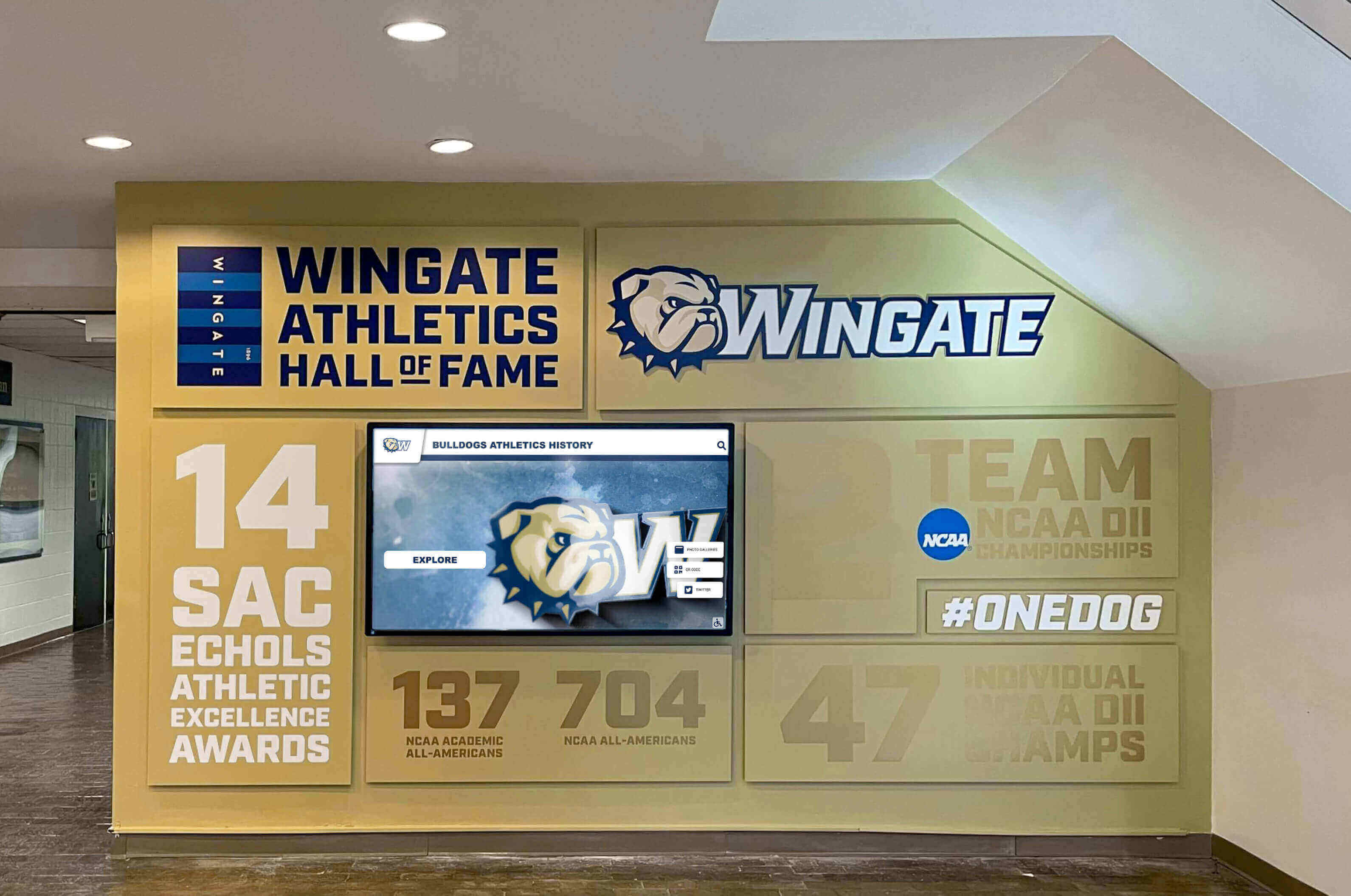
Modern alumni recognition displays create welcoming spaces that celebrate achievement and inspire pride
Understanding Alumni Recognition: More Than Names and Awards
Alumni recognition encompasses all the ways institutions formally acknowledge, celebrate, and honor graduate achievements, contributions, and milestones. At its most basic level, recognition answers a fundamental human need—to be seen, appreciated, and remembered by communities that shaped us. For alumni, institutional recognition validates their educational investment while affirming ongoing connections to places and people that influenced their life trajectories.
The Strategic Importance of Alumni Recognition
Forward-thinking institutions view recognition as strategic infrastructure rather than ceremonial courtesy. Research consistently demonstrates that recognized alumni exhibit stronger engagement patterns across multiple dimensions compared to unrecognized peers. They attend events more frequently, volunteer more readily, donate more generously, and advocate more enthusiastically for institutional interests.
This engagement correlation makes intuitive sense. When institutions publicly celebrate alumni success, graduates internalize messages that their alma mater takes pride in their achievements and values their ongoing relationship. This validation creates reciprocal obligations—if the institution honors my accomplishments, I should support its mission. Recognition initiates positive reinforcement cycles where acknowledgment generates engagement, which merits additional recognition, creating upward spirals of mutual investment and connection.
Beyond individual relationship benefits, recognition programs deliver institutional advantages including:
Reputation Enhancement: Showcasing successful alumni demonstrates educational quality through evidence rather than marketing claims. Prospective students, families, employers, and community partners judge institutions partly by graduate outcomes. Recognition programs make these outcomes visible, credible, and compelling.
Current Student Inspiration: Students benefit tremendously from visible examples of achievable success. When students see graduates from their institution excelling in fields they’re considering, abstract career aspirations become tangible possibilities. Academic recognition programs help current students envision their own potential paths forward.
Donor Cultivation: Recognition serves advancement objectives by identifying accomplished alumni who possess both philanthropic capacity and emotional connection. Distinguished professionals often welcome opportunities to give back to institutions that celebrate their success. Moreover, recognition itself provides stewardship opportunities—honoring donors publicly for their generosity encourages continued and expanded support.
Community Building: Recognition creates shared institutional pride that transcends individual achievement. Alumni feel proud not only of their own accomplishments but of fellow graduates’ successes. This collective pride strengthens alumni community identity and motivates participation in programs that sustain these connections.
Institutional Memory Preservation: Recognition programs document organizational history through the graduates who shaped various eras. These archives preserve stories, achievements, and contributions that might otherwise be lost, creating valuable historical resources for future generations.
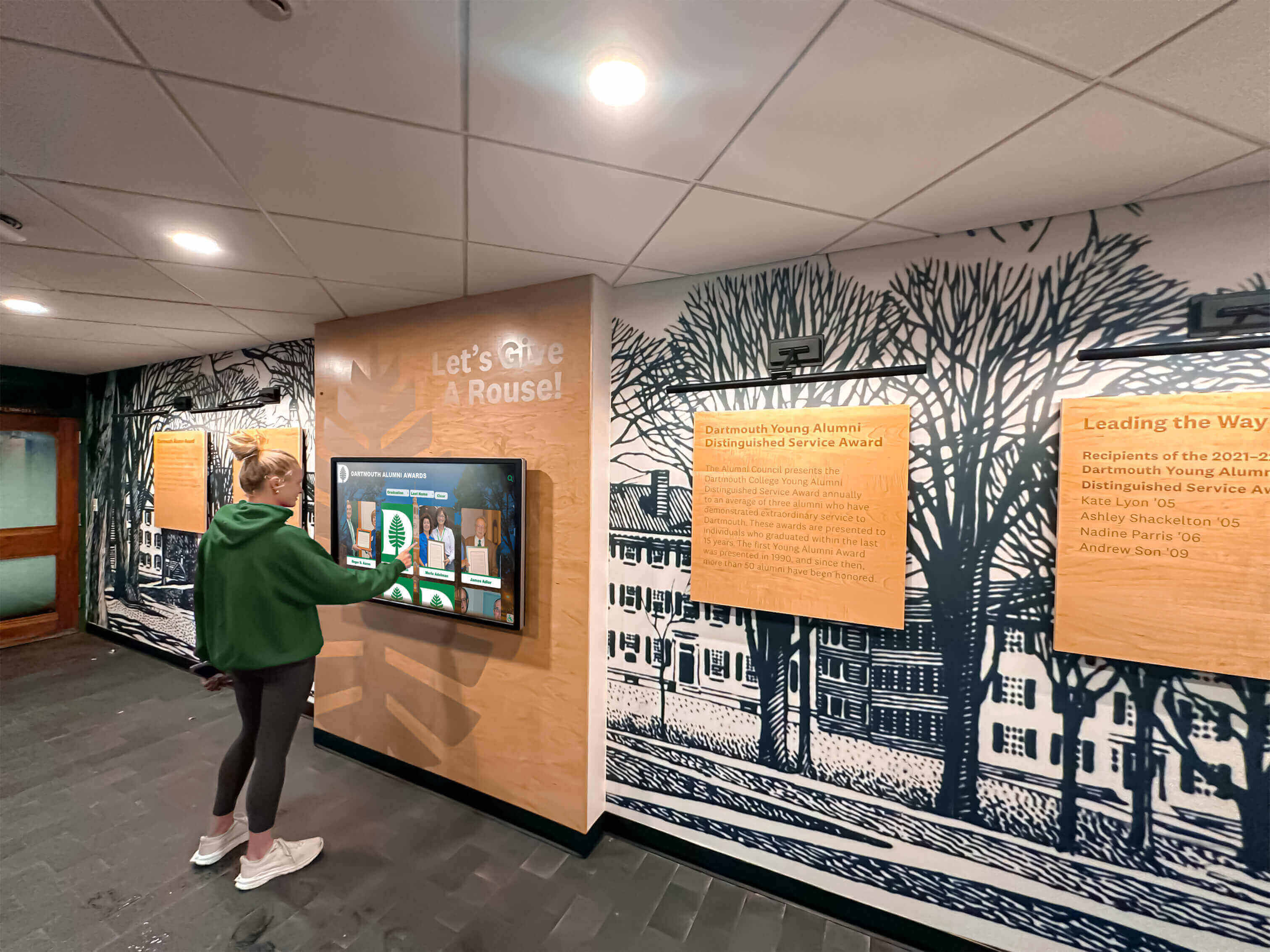
Interactive alumni displays inspire current students by showcasing achievable success pathways
The Psychology Behind Recognition Impact
Understanding why recognition drives engagement requires examining fundamental psychological principles that govern human motivation and behavior. Several interconnected factors explain recognition’s powerful effects:
Social Recognition Theory: Humans are inherently social creatures who seek validation from groups they value. Educational institutions represent formative communities where individuals developed identities, acquired knowledge, formed friendships, and established career foundations. Recognition from these significant communities carries disproportionate weight compared to acknowledgment from less meaningful sources.
Reciprocity Principle: The social norm of reciprocity creates expectations that people return favors and positive actions. When institutions honor alumni through recognition, graduates experience subtle pressure to reciprocate through engagement, support, or contribution. This reciprocity operates even when recognition isn’t explicitly tied to expectations of return action.
Self-Concept Affirmation: Recognition affirms positive self-concepts by providing external validation of accomplishments. Alumni who receive institutional recognition experience confirmation that their achievements merit acknowledgment from respected authorities. This affirmation strengthens self-efficacy while reinforcing connections to institutions that provide validating feedback.
Belonging Reinforcement: Recognition programs communicate that honored individuals belong to exclusive communities of achievement. This belonging satisfies fundamental human needs for social connection while creating identity ties that persist across time and distance. Alumni who see themselves as permanent members of institutional communities maintain engagement far more reliably than those viewing their connection as purely transactional.
Legacy and Meaning: Recognition addresses existential desires to create lasting meaning and leave legacies that transcend individual lifespans. Alumni honored through institutional recognition achieve a form of permanence—their names, stories, and achievements become part of institutional narratives that persist beyond their years. This legacy creation provides profound psychological satisfaction that motivates continued investment in organizations that preserve memory.
These psychological mechanisms explain why thoughtfully implemented recognition generates disproportionate engagement compared to resources invested. Recognition satisfies deep human needs that purely transactional relationships cannot address, creating emotional bonds that sustain long-term institutional connections.
Types of Alumni Recognition Programs: A Comprehensive Framework
Effective alumni recognition strategies employ multiple program types addressing diverse achievements, contribution patterns, and engagement stages. Rather than relying on single recognition approaches, successful institutions implement comprehensive frameworks that celebrate achievement across many dimensions.
Award-Based Recognition Programs
Traditional award programs remain recognition cornerstones, providing formal acknowledgment of exceptional achievement through structured selection processes and public ceremonies.
Distinguished Alumni Awards: These prestigious honors recognize extraordinary lifetime achievement across professional, creative, humanitarian, or civic domains. Selection criteria typically require sustained excellence over decades rather than single accomplishments. Distinguished alumni award recipients often represent institutional flagships—graduates whose achievements bring credit to their alma maters while exemplifying excellence that inspires others. Recipients commonly receive physical awards, public recognition at major events, touchscreen hall of fame inductions, and permanent institutional acknowledgment.
Early Career Achievement Awards: Recognizing recent graduates who’ve demonstrated exceptional promise encourages younger alumni engagement while celebrating emerging talent. These awards acknowledge graduates making significant impact within 5-15 years post-graduation through entrepreneurial ventures, professional advancement, creative work, or community leadership. Early career recognition benefits institutions by connecting with younger demographics who might otherwise defer engagement until later life stages.
Outstanding Service Awards: Many deserving alumni never achieve headline-grabbing professional success but contribute immeasurably through volunteer service, mentorship, governance, or advocacy. Service awards honor these essential contributions, demonstrating that recognition extends beyond famous graduates to include everyone who advances institutional missions through selfless engagement.
Professional Excellence Awards: Category-specific awards recognize achievement within particular professional fields—business leadership, educational excellence, healthcare innovation, legal distinction, engineering accomplishment, or artistic achievement. Field-specific recognition allows institutions to honor diverse excellence while providing relatable role models across occupational domains students pursue.
Humanitarian and Community Impact Awards: Graduates who dedicate careers to nonprofit work, social justice, community development, or humanitarian service merit recognition equal to corporate executives or professional achievers. These awards affirm that institutional values extend beyond professional success to include service, compassion, and societal contribution.
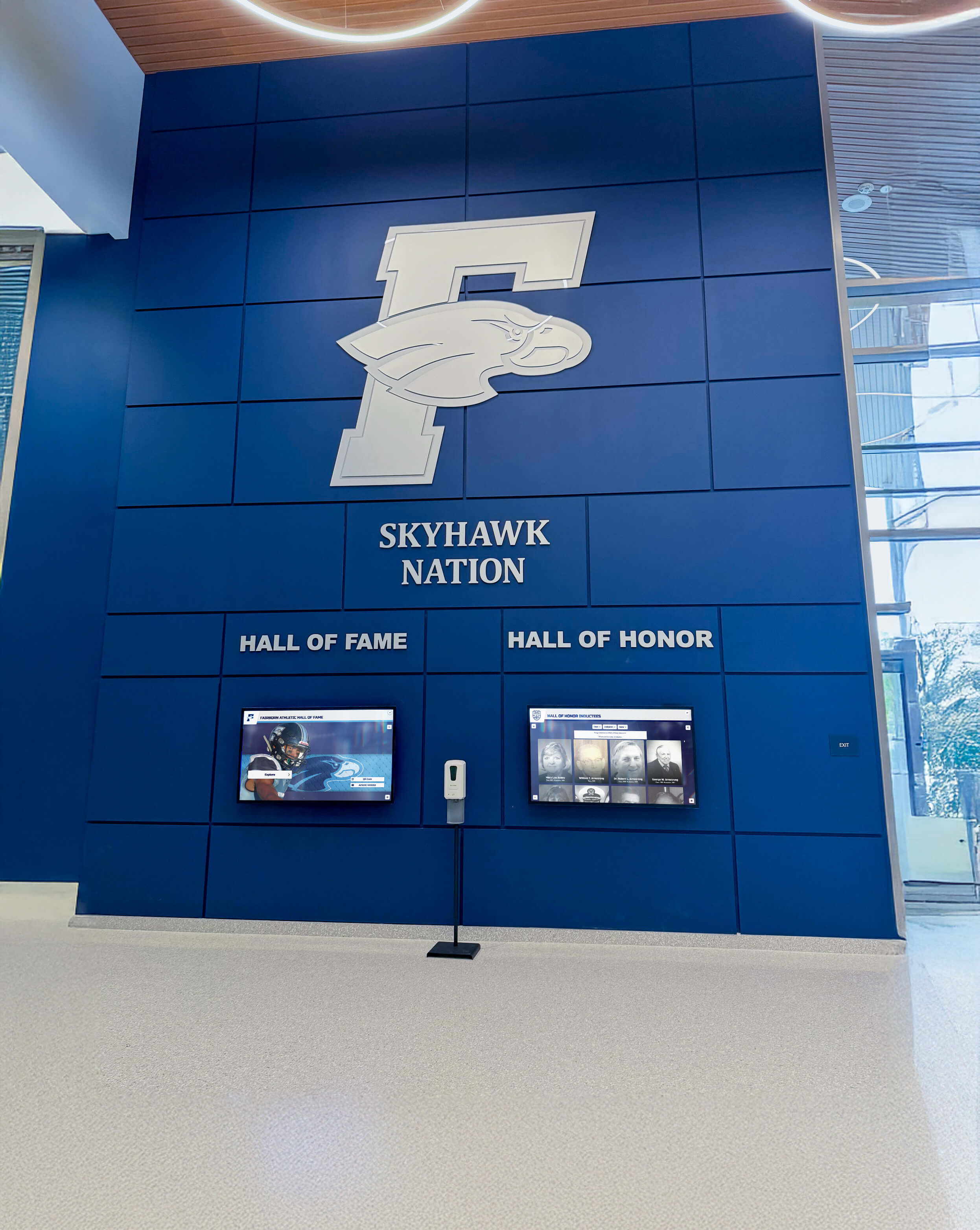
Award programs create ceremonial moments that honor achievement while strengthening community bonds
Athletic Recognition Programs
Athletic achievement represents distinct recognition categories given sports’ visibility and importance within institutional cultures, particularly in schools with competitive programs.
Athletics Hall of Fame: Athletic halls of fame honor student-athletes, coaches, and athletic administrators who achieved distinction through competitive excellence, record-breaking performances, championship contributions, or sustained coaching success. Selection criteria typically balance individual statistics with team contributions, championship participation, sportsmanship demonstration, and post-graduation athletic or professional achievement.
All-State and All-Conference Recognition: High schools and colleges commonly honor athletes who earned all-state, all-conference, or all-American recognition during their competitive careers. These honors acknowledge elite competitive achievement while preserving records of athletic excellence across institutional history. Modern all-state athlete recognition displays make these achievements visible to current student-athletes and campus visitors.
Record Holder Recognition: Athletes who established institutional records in specific events, performances, or statistical categories receive permanent recognition for these achievements. Record boards document fastest times, highest scores, longest distances, and other superlative performances, creating competitive motivation for current athletes while honoring historical excellence.
Team Championship Honors: Beyond individual achievement, recognition programs celebrate championship teams that brought glory to institutions through conference titles, state championships, national tournaments, or other competitive excellence. Team recognition preserves collective achievement while honoring every member who contributed to championship success.
Letter Winner Acknowledgment: Many programs recognize all athletes who earned varsity letters, not just standout performers. This inclusive approach honors every student-athlete who represented institutions competitively while demonstrating that participation itself merits acknowledgment.
Academic and Professional Recognition
Academic achievement provides fertile ground for recognition programs that inspire current students while celebrating intellectual excellence.
Academic Hall of Distinction: Parallel to athletic halls of fame, academic recognition programs honor graduates who achieved scholarly distinction through research contributions, academic leadership, educational innovation, or intellectual impact. These programs demonstrate that academic achievement receives equivalent honors to athletic and professional success.
Faculty Achievement Awards: Recognizing distinguished faculty honors professors whose teaching, research, or service shaped institutional excellence while acknowledging their profound influence on student development. Faculty recognition reinforces educational mission centrality while celebrating those who make academic achievement possible.
Research and Innovation Recognition: Graduates who contribute significant research, develop important innovations, earn patents, publish influential work, or advance knowledge boundaries merit specialized recognition celebrating intellectual contribution. These programs particularly matter for research-intensive institutions where scholarship defines institutional identity.
Professional Board and Leadership Recognition: Many alumni serve their professions through board leadership, association governance, standard-setting, or policy development. Recognizing these professional contributions acknowledges influence that extends beyond individual careers to shape entire fields or industries.
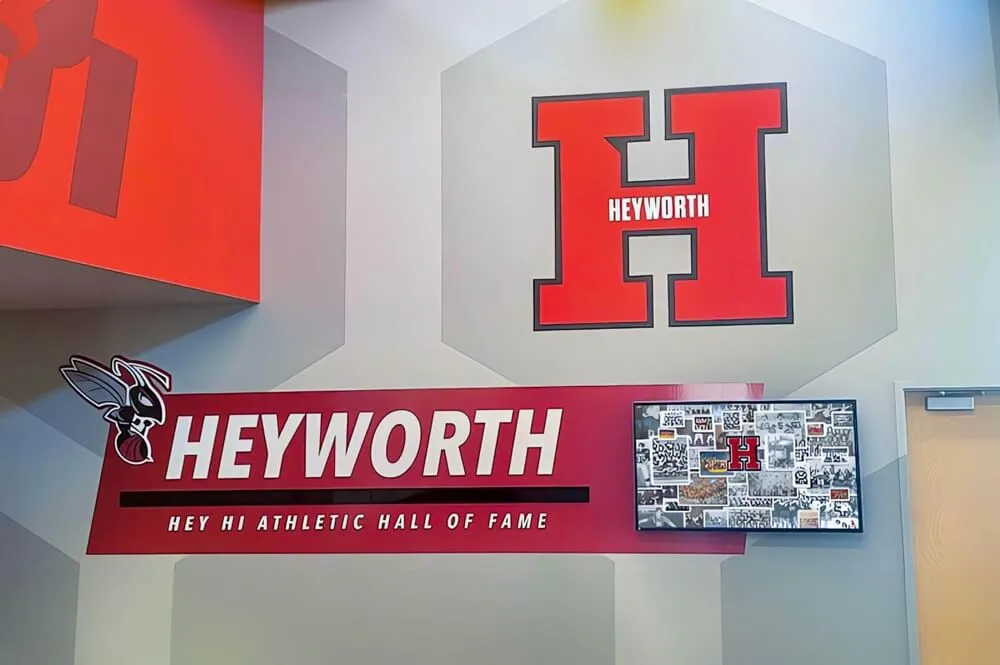
Comprehensive recognition programs celebrate both athletic and academic excellence across institutional history
Donor Recognition Programs
Financial support merits acknowledgment that honors generosity while encouraging continued philanthropy. Digital donor recognition displays provide dynamic platforms for celebrating philanthropic partnership.
Cumulative Giving Recognition: Tiered recognition based on lifetime giving totals honors sustained philanthropic commitment. Recognition societies—President’s Circle, Founder’s Society, Legacy Guild—create aspirational giving levels while publicly acknowledging those who’ve achieved threshold amounts. These programs encourage giving progression as donors approach next recognition tiers.
Annual Fund Recognition: Acknowledging annual donors ensures that modest but consistent givers receive appreciation alongside major gift benefactors. Recognition categories like “consecutive years giving” honor loyalty even when individual gift amounts remain small. This inclusive approach prevents alienating majority alumni who give modestly but faithfully.
Planned Giving Recognition: Alumni who establish planned gifts, bequests, or legacy commitments deserve special recognition for generosity that extends beyond their lifetimes. Legacy societies honor these forward-thinking donors while inspiring others to consider similar estate planning.
Endowment and Naming Recognition: Major gifts that create endowments or earn naming opportunities receive permanent recognition through named scholarships, professorships, buildings, or programs. This high-level recognition provides lasting legacy while inspiring transformational giving from capable donors seeking meaningful memorial.
Impact Recognition: Beyond financial acknowledgment, effective donor recognition demonstrates giving impact. Showcasing how contributions enabled student scholarships, funded research breakthroughs, improved facilities, or expanded programs helps donors understand that their generosity created tangible results worth celebrating.
Ongoing and Inclusive Recognition Approaches
Beyond formal awards, sustained recognition practices create continuous acknowledgment touchpoints that keep alumni feeling valued throughout their lives.
Alumni Spotlight Features: Regular spotlight features highlighting different alumni create ongoing recognition opportunities without requiring formal selection processes. Monthly alumni spotlight programs can feature diverse graduates representing various achievement types, eras, and professional fields. These spotlights democratize recognition while generating steady content for communications channels.
Milestone Celebrations: Acknowledging personal and professional milestones—graduations, promotions, elections, publications, retirements, marriages, births—shows institutional interest in alumni lives beyond transactional advancement objectives. Milestone recognition requires systematic data collection but creates meaningful touchpoints that strengthen emotional bonds.
Class Reunion Recognition: Reunion years provide natural recognition opportunities for entire classes. Special reunion weekend events, commemorative materials, class gift challenges, and dedicated recognition displays honor reunion classes collectively while motivating attendance and giving.
Volunteer Recognition: Alumni who serve as mentors, event volunteers, admissions ambassadors, career advisors, or board members contribute invaluable time and expertise. Volunteer appreciation events, service milestone acknowledgment, and volunteer halls of honor ensure that non-financial contributions receive deserved recognition.
Social Media Recognition: Digital platforms enable immediate, public recognition through social media acknowledgment. Sharing alumni accomplishments via institutional accounts, tagging individuals in celebratory posts, and featuring success stories in digital communications provide recognition that reaches alumni where they already spend time online.
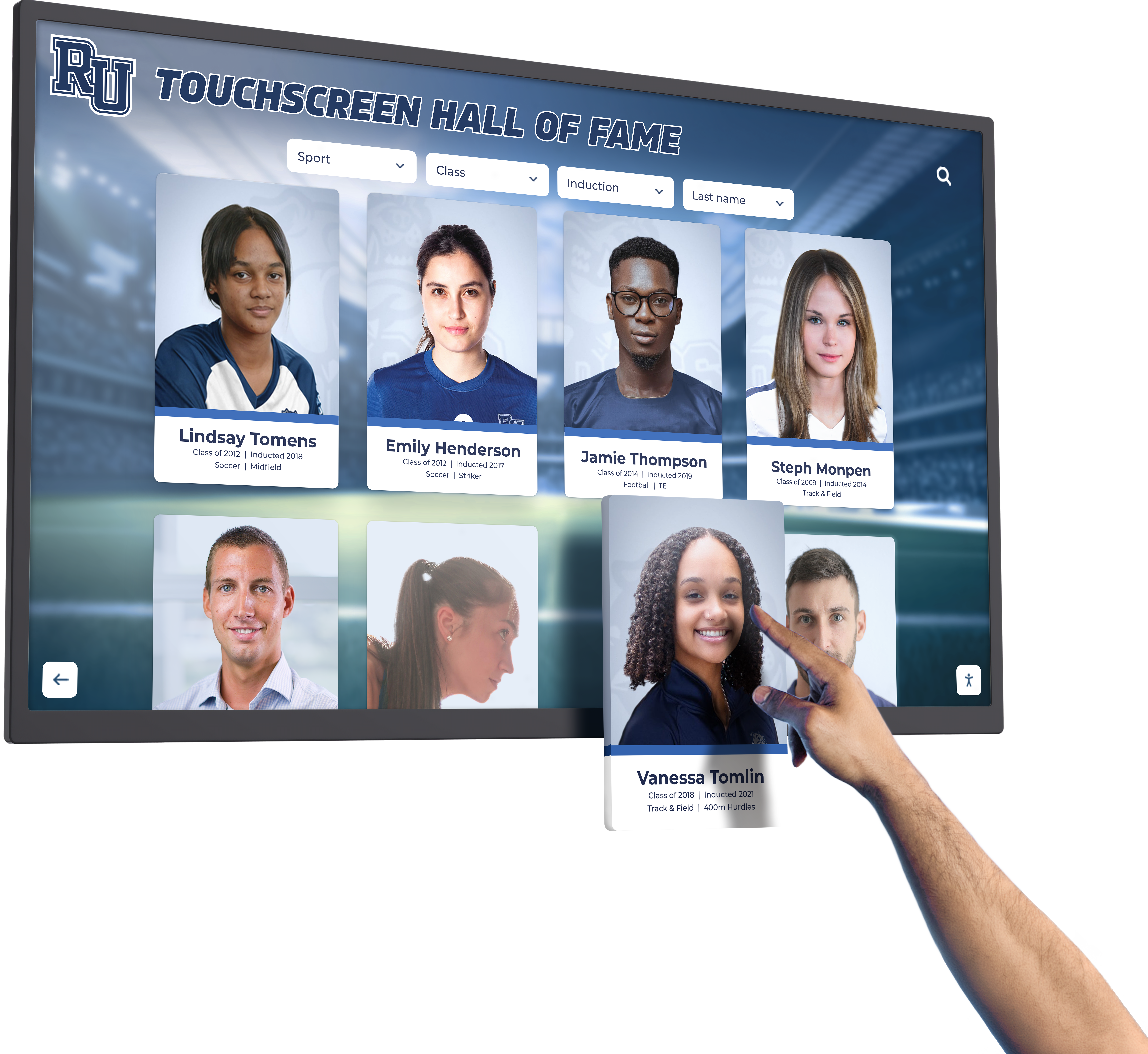
Interactive digital displays enable rich, multimedia recognition experiences that engage visitors deeply
Building Effective Alumni Recognition Programs: Implementation Strategies
Creating recognition programs that deliver strategic results requires systematic planning, stakeholder engagement, and sustainable operational frameworks. Successful programs share common implementation characteristics regardless of institutional size or resources.
Establishing Recognition Criteria and Selection Processes
Clear, transparent criteria ensure recognition programs maintain credibility and fairness while avoiding perceptions of favoritism or arbitrary selection.
Defining Achievement Standards: Specify what constitutes recognition-worthy achievement within various categories. Criteria might include career distinction (C-suite leadership, professional prominence), community impact (nonprofit leadership, public service), creative accomplishment (published works, artistic recognition), athletic excellence (professional competition, coaching success), or institutional service (board membership, volunteer leadership). Documented standards provide selection guidance while setting expectations for potential nominees.
Creating Inclusive Categories: Ensure recognition frameworks accommodate diverse achievement types that reflect your entire alumni community. Avoid overemphasizing traditional professional success at the expense of equally valuable contributions in education, creative fields, social services, or community development. Balanced categories communicate that all excellent achievement merits recognition regardless of field.
Nomination Processes: Establish accessible nomination procedures allowing diverse stakeholders to suggest recognition candidates. Open nomination systems where anyone can propose candidates generate broader awareness while surfacing deserving alumni who might otherwise remain overlooked. Online nomination forms, deadline promotion, and confirmation communications make nomination straightforward and transparent.
Selection Committee Composition: Convene diverse committees representing various constituencies—alumni from different eras, faculty members, advancement professionals, student representatives, and community partners. Diverse committees ensure multiple perspectives inform selection while preventing single individuals from dominating decisions. Rotating committee membership prevents entrenchment while maintaining institutional memory through staggered terms.
Evaluation Criteria and Scoring: Develop rubrics that objectively assess nominations against established criteria. Scoring systems that weight various achievement dimensions enable systematic evaluation while reducing subjective bias. Document evaluation rationales to demonstrate thorough, principled consideration even for non-selected nominees who might inquire about decisions.
Confidentiality and Communication: Maintain nomination and selection confidentiality until official announcements. Premature disclosure undermines ceremonial unveiling while creating uncomfortable situations if selections change. Once decided, communicate promptly with honorees, unsuccessful nominees, and broader communities through coordinated announcements that maximize visibility and impact.
Designing Recognition Ceremonies and Events
Public ceremonies provide formal contexts for conferring recognition while creating memorable experiences that strengthen community bonds.
Annual Recognition Galas: Dedicated recognition events—alumni awards dinners, hall of fame induction ceremonies, or achievement celebration receptions—provide ceremonial contexts appropriate to recognition significance. These events combine formal award presentations with social networking, creating meaningful experiences for honorees, families, and institutional communities.
Integration with Existing Events: Budget-conscious institutions often integrate recognition into established events rather than creating separate programs. Homecoming weekends, athletic contests, donor appreciation events, or commencement ceremonies provide ready-made audiences and existing event infrastructure, reducing planning burden while ensuring substantial attendance.
Virtual and Hybrid Recognition Events: Geographic dispersion and scheduling challenges often prevent alumni from attending in-person ceremonies. Virtual or hybrid recognition events enable remote participation while recording proceedings for on-demand viewing. This approach dramatically expands accessibility while creating content for ongoing communications.
Recognition Display Unveilings: When inducting alumni into halls of fame or adding profiles to interactive recognition displays, coordinate unveilings with honoree presence when possible. Personal participation adds significance while creating photo and video opportunities that enhance promotional value.
Student Participation: Include students in recognition ceremonies as attendees, presenters, or performers. Student involvement exposes current enrollees to alumni achievement while creating intergenerational connections. Many honorees find student presence particularly meaningful, reinforcing that their recognition inspires next generations.
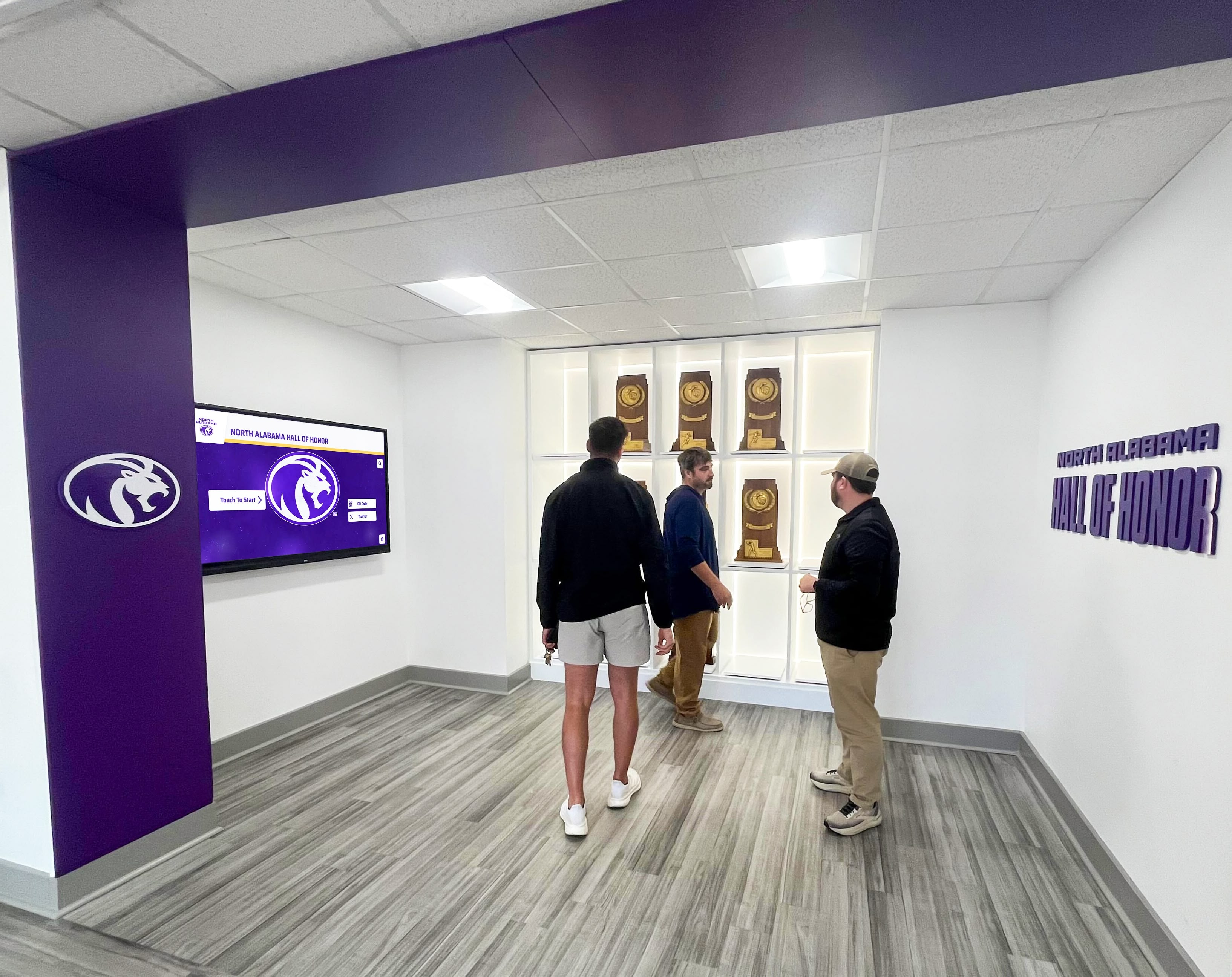
Recognition ceremonies create meaningful moments that bring communities together in celebration of shared excellence
Creating Physical and Digital Recognition Displays
Modern recognition strategies combine physical campus displays with digital platforms that extend visibility globally while accommodating unlimited recognition capacity.
Traditional Display Methods: Conventional recognition approaches include engraved plaques mounted in dedicated spaces, trophy cases displaying awards and memorabilia, photographic galleries featuring recognized alumni, or printed directories listing honorees. While traditional, these methods provide permanent, visible campus presence that communicates institutional values to daily visitors.
Digital Interactive Displays: Solutions like Rocket Alumni Solutions’ touchscreen displays transform recognition through interactive technology. Commercial-grade touchscreen installations enable visitors to explore comprehensive alumni profiles, search by name or category, view photos and videos, and discover achievements in depth impossible with static displays. These systems accommodate unlimited profiles while enabling instant updates as new honorees are added or existing profiles are enhanced.
Location and Placement Strategy: Strategic display placement in high-traffic areas—main lobbies, student centers, athletic facilities, alumni centers—maximizes visibility while ensuring regular interaction. Consider viewing angles, lighting conditions, accessibility compliance, and integration with surrounding architecture when planning installations.
Online Recognition Platforms: Web-based recognition platforms extend acknowledgment beyond campus boundaries, allowing global alumni to explore recognition programs remotely. These digital extensions should mirror physical display functionality while leveraging online-specific capabilities like social sharing, personalized recommendations, and integration with alumni databases. Online hall of fame platforms ensure recognition reaches alumni regardless of geographic distance.
Mobile Optimization: Many alumni primarily access institutional content through smartphones. Recognition platforms must function excellently on mobile devices with responsive design, touch-friendly interfaces, and fast loading optimized for mobile networks. Mobile-first design ensures recognition reaches alumni where they naturally engage with digital content.
Content Management Systems: Recognition displays require user-friendly management systems enabling non-technical staff to add profiles, upload media, update information, and publish content without IT intervention. Cloud-based platforms eliminate server requirements while providing remote administration from any internet-connected device. Look for solutions offering drag-and-drop editing, bulk import capabilities, scheduled publishing, and role-based permissions for distributed content management.
Developing Compelling Recognition Content
Technology enables recognition, but compelling content drives engagement. Profiles that tell authentic stories create emotional connections that honor alumni appropriately while inspiring visitors.
Biographical Narratives: Move beyond basic credentials to share career journeys, pivotal moments, challenges overcome, and lessons learned. Alumni profiles that describe how education influenced trajectories resonate powerfully with current students evaluating educational investments. Focus on transformation—how did the educational experience shape the person and enable the achievement?
Visual Storytelling: Professional photography showing alumni at various life stages, in professional environments, or engaged in work they love brings profiles to life. Video interviews where alumni share personal reflections, offer student advice, or describe formative institutional experiences create authentic connections that static text cannot match.
Achievement Documentation: Balance personal narrative with specific accomplishment details—awards received, positions held, innovations developed, impact created. Specificity makes achievement tangible and credible rather than abstract. Include dates, organizations, recognitions, and measurable outcomes that demonstrate impact.
Connection Opportunities: Include information enabling networking—professional fields, geographic locations, LinkedIn profiles, or mentorship availability. Recognition content that facilitates alumni-to-alumni or alumni-to-student connections provides ongoing utility beyond static acknowledgment.
Multimedia Integration: Leverage video testimonials, audio clips, document scans, news articles, social media feeds, and interactive timelines that enrich profiles beyond text and photos. Rich media creates immersive experiences while accommodating diverse content consumption preferences.
Update Sustainability: Design content processes that remain manageable long-term. Create profile templates ensuring consistency while reducing development effort. Enable alumni self-submission of information, photos, and updates. Assign reasonable content standards you can maintain across hundreds of profiles rather than creating a few exceptional features alongside sparse listings for most honorees.
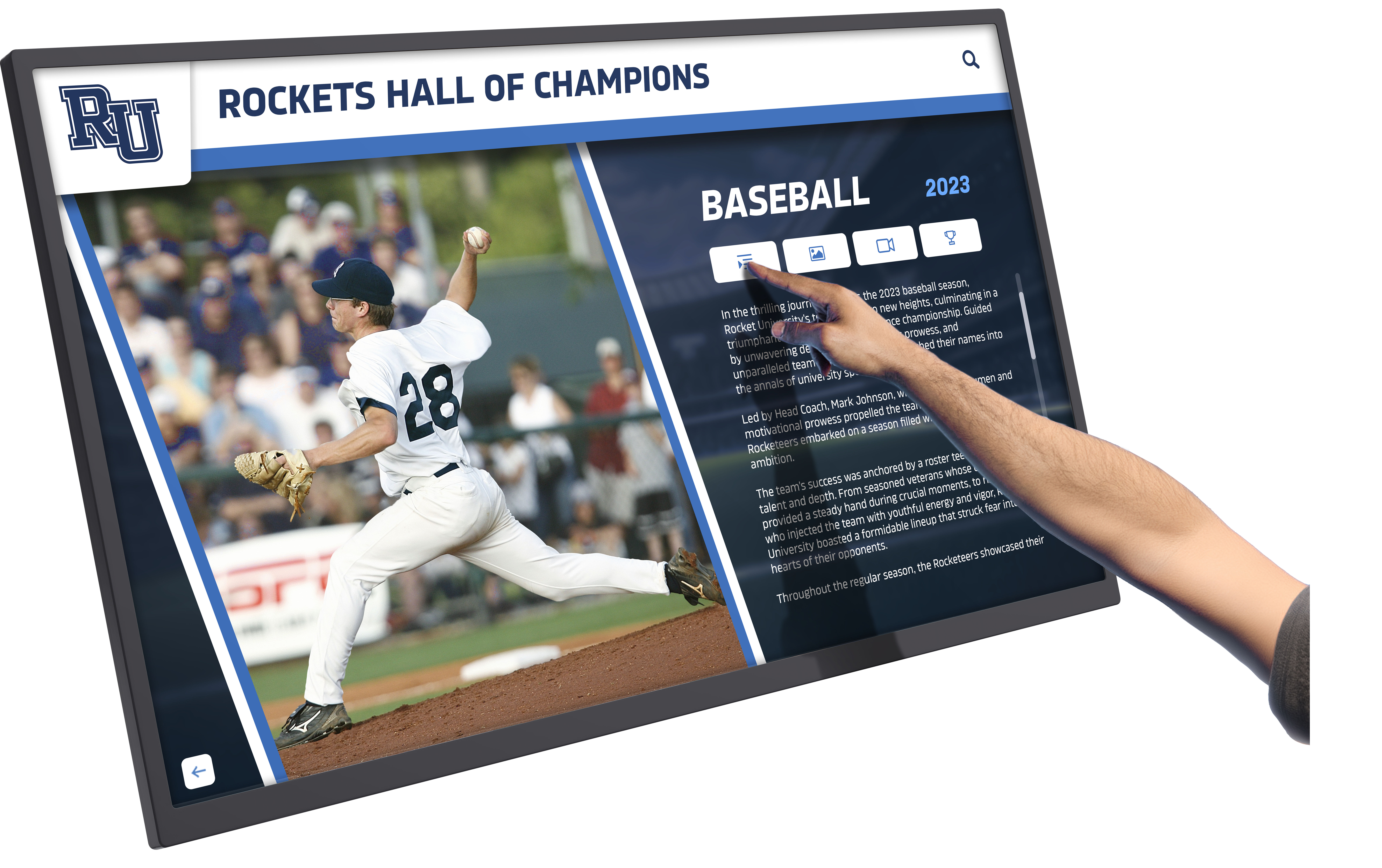
Rich multimedia content transforms recognition from simple acknowledgment into engaging storytelling experiences
Leveraging Technology for Modern Alumni Recognition
Digital transformation has revolutionized recognition capabilities, enabling experiences impossible with traditional approaches. Understanding available technologies helps institutions select solutions that align with goals, budgets, and technical capacity.
Interactive Touchscreen Recognition Systems
Commercial-grade touchscreen displays provide intuitive interfaces for exploring recognition content through familiar touch gestures similar to smartphones and tablets.
Display Hardware Considerations: Screen size, resolution, touch technology, durability, and installation options significantly impact user experience and long-term satisfaction. Commercial displays rated for continuous operation far exceed consumer products in reliability and longevity. Capacitive touch technology provides responsive, precise interaction users expect. Resolution of 4K or higher ensures crisp text at close viewing distances while supporting high-quality photo and video display.
Software Capabilities: Purpose-built recognition software designed specifically for educational institutions offers advantages over generic content management systems. Look for features including intuitive search and filtering, multimedia support, cloud-based administration, automatic content synchronization, analytics tracking, accessibility compliance, and customization matching institutional branding. Solutions like Rocket Alumni Solutions’ platforms provide these capabilities through specialized systems refined across hundreds of institutional implementations.
Content Management Requirements: Non-technical staff should manage recognition content independently through web-based interfaces requiring no coding knowledge. Essential management features include drag-and-drop editing, bulk import tools for historical data migration, media libraries for asset organization, scheduled publishing, version control, and role-based permissions. Cloud-based systems eliminate IT infrastructure requirements while enabling remote administration from anywhere with internet access.
Installation Flexibility: Recognition displays accommodate various installation configurations depending on space and preferences. Wall-mounted installations provide sleek, space-efficient options for locations with appropriate structural support. Freestanding kiosks offer portability and flexibility without requiring wall mounting. Custom architectural integration seamlessly blends displays into existing spaces. Multi-display arrays create immersive recognition environments showcasing extensive content across coordinated screens.
Web-Based Recognition Platforms
Companion websites extend recognition beyond campus, allowing global access while creating shareable content that amplifies visibility through social networks.
Responsive Design Requirements: Recognition websites must function excellently across all devices—desktop computers, tablets, and smartphones—without requiring separate mobile apps. Responsive design automatically adapts layout, navigation, and content presentation based on screen size, ensuring optimal experience regardless of access method.
Search Engine Optimization: Well-structured recognition websites attract organic traffic from search engines when people search recognized alumni names, achievement keywords, or institutional information. Proper SEO practices including descriptive page titles, meta descriptions, structured data markup, and keyword optimization help recognition content surface in relevant searches, extending visibility beyond institutional audiences.
Social Media Integration: Enable one-click sharing of profiles to social platforms with preview images and descriptions that display attractively in social feeds. When alumni share recognition with personal networks, institutional visibility expands exponentially. Integrated social feeds might display recognition-related posts, creating dynamic content that keeps platforms current without manual updates.
Analytics and Measurement: Comprehensive analytics reveal engagement patterns, popular content, navigation behaviors, and conversion rates for calls-to-action. Tracking unique visitors, session duration, profiles viewed, search patterns, device types, and geographic distribution provides data-driven insights for optimizing recognition programs while demonstrating value to institutional stakeholders.
Alumni Database Integration: Connecting recognition platforms with existing alumni databases enables data synchronization, reduces redundant entry, and supports personalized experiences. Integration might automatically update recognition profiles when alumni update contact information or enable authenticated alumni to submit profile updates for staff review before publication.
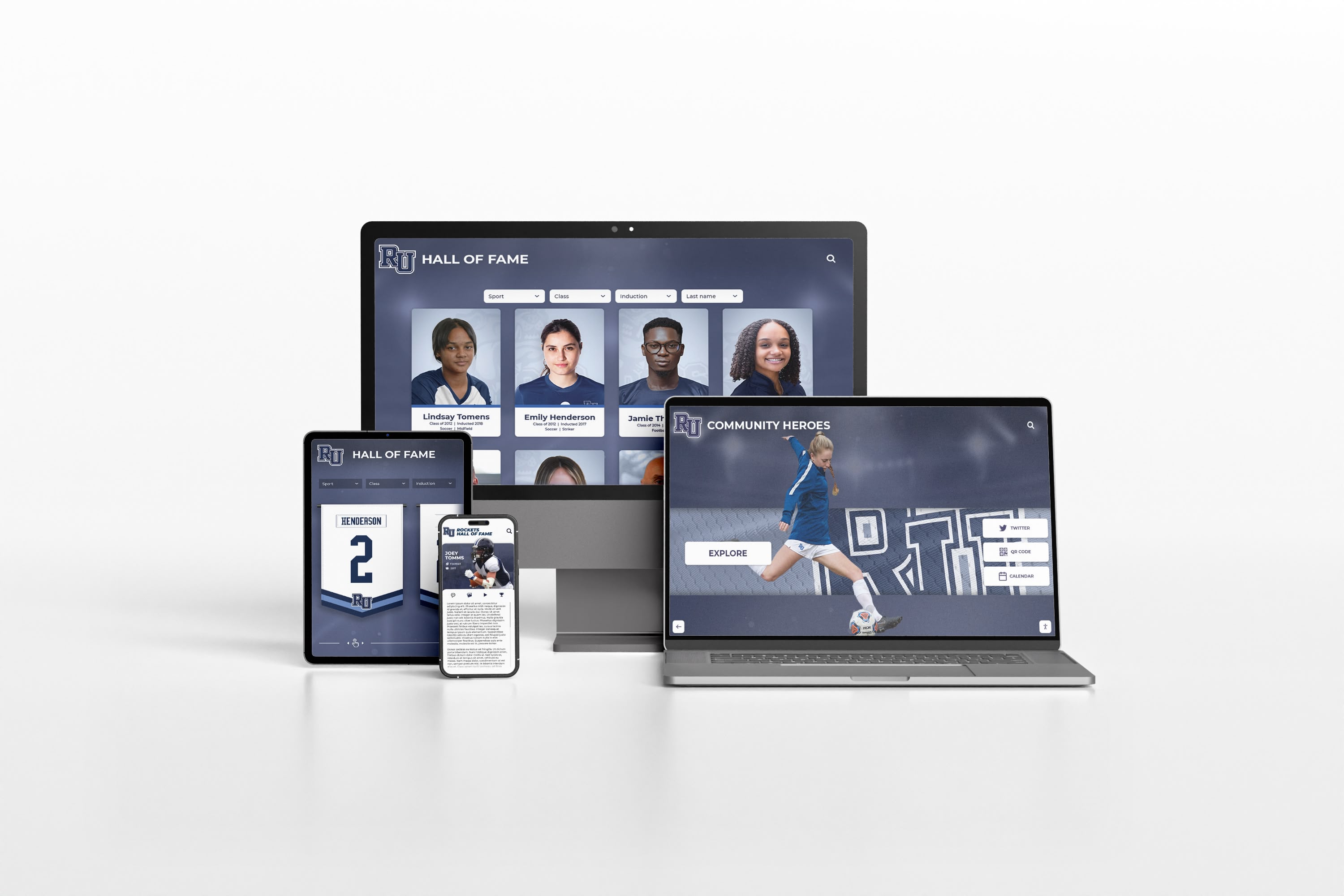
Responsive recognition platforms ensure excellent experiences across all devices from smartphones to large displays
Emerging Technologies in Alumni Recognition
Innovative technologies continue expanding recognition possibilities through capabilities that will become increasingly mainstream in coming years.
Artificial Intelligence Applications: AI enhances recognition through personalized content recommendations, natural language search accepting conversational queries, automated content tagging and categorization, video transcription and captioning, and photo enhancement. These capabilities reduce administrative burden while improving discoverability and user experience.
Virtual and Augmented Reality: Immersive technologies enable novel recognition experiences. Virtual reality creates accessible digital halls of fame that remote alumni explore through VR headsets as if physically present. Augmented reality overlays digital content onto physical environments when users point smartphones at displays, bridging traditional and digital recognition. 3D artifact scanning preserves trophies, awards, and memorabilia digitally for interactive exploration impossible with physical constraints.
Blockchain Credentialing: Distributed ledger technology enables verifiable digital credentials documenting recognition permanently in tamper-proof records. Blockchain credentials provide portable, shareable achievement verification that alumni control and share with employers, professional networks, or other institutions.
Measuring Alumni Recognition Program Success
Effective programs demonstrate value through quantifiable metrics and qualitative feedback. Data-driven assessment justifies investment, informs continuous improvement, and builds institutional support for ongoing development.
Key Performance Indicators
Engagement Metrics: Track physical display interactions, website traffic, session duration, profiles viewed per visit, return visitor rates, search activity patterns, and social media shares. These usage statistics reveal how actively audiences engage with recognition content while identifying popular features and content types.
Advancement Impact: Monitor changes in alumni giving participation rates, average gift amounts from recognized versus unrecognized alumni, major gift pipeline development, planned giving inquiries, event attendance, and volunteer recruitment. Correlating recognition with advancement outcomes demonstrates tangible return on investment that justifies program costs.
Recognition Breadth: Measure total alumni recognized, demographic diversity of honorees, achievement category representation, temporal distribution across graduation eras, and annual recognition rates. These metrics ensure programs maintain inclusive, comprehensive coverage rather than narrowly focusing on traditional professional success or recent graduates.
Satisfaction Indicators: Survey honorees about recognition experiences, solicit feedback from ceremony attendees, gather testimonials from alumni families, and collect input from staff managing programs. Qualitative feedback complements quantitative metrics while revealing improvement opportunities.
Operational Efficiency: Calculate administrative time required for content management, cost per alumnus recognized, update frequency, and content backlog status. Efficiency metrics help assess whether programs operate sustainably or risk becoming overwhelming burdens that cannot be maintained long-term.
Continuous Improvement Through Data Analysis
Regular analysis reveals patterns that inform strategic refinement and tactical optimization.
Content Performance Review: Identify most-viewed profiles to understand resonant content characteristics. Analyze underperforming content to diagnose issues—perhaps sparse information, missing photos, or outdated details warrant enhancement. Use insights to refine content standards and development priorities.
User Behavior Analysis: Study navigation patterns revealing how visitors discover content. High search activity for terms that yield no results indicates content gaps or metadata deficiencies requiring attention. Feature usage analysis shows which capabilities matter versus those cluttering interfaces without adding value.
Demographic Analysis: Compare engagement patterns across graduation decades, professional fields, geographic regions, and demographic groups. Disparities might reveal that certain populations lack awareness of recognition programs, face accessibility barriers, or feel underrepresented in honored alumni, suggesting targeted outreach or expanded selection criteria.
Temporal Pattern Recognition: Identify engagement peaks surrounding specific events, reunion weekends, giving campaigns, or communication initiatives. Time recognition updates, promotional efforts, and induction announcements to coincide with high-engagement windows that maximize visibility and impact.
Benchmark Comparison: When possible, compare performance against peer institutions or industry standards. Benchmark data provides context for assessing whether your programs achieve competitive engagement levels or lag behind comparable organizations.
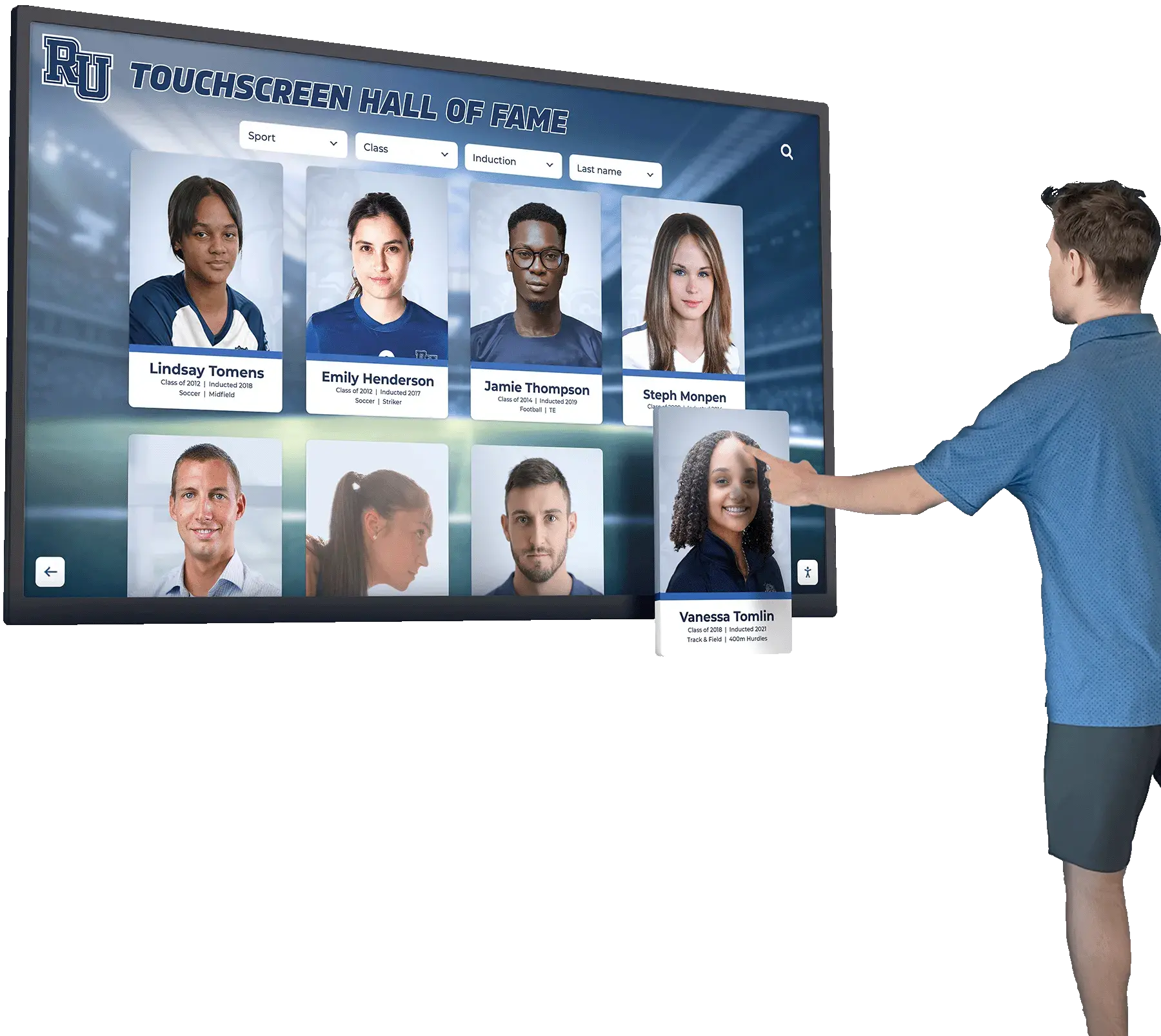
Data-driven insights enable continuous optimization that maximizes recognition program impact and institutional return
Best Practices for Sustainable Recognition Programs
Institutions achieving exceptional long-term results share common practices that prevent initial enthusiasm from fading into neglected programs requiring eventual overhaul.
Leadership Support and Resources
Executive Champion Assignment: Designate senior leaders as recognition program champions who provide visibility, remove obstacles, and ensure resources. Presidential or vice presidential involvement signals institutional commitment while elevating recognition to strategic priority status rather than optional courtesy.
Adequate Staffing: Recognition programs require dedicated time from professionals who develop content, coordinate events, manage technology, and measure results. Treating recognition as additional responsibility for already-overloaded staff ensures mediocre execution. Appropriate staffing might include dedicated personnel or meaningful percentage allocations from advancement, communications, and alumni relations professionals.
Sustainable Budgets: Beyond initial implementation costs, recognition programs need ongoing funding for technology subscriptions, content development, event expenses, marketing materials, and periodic hardware refreshes. Multi-year budget commitments prevent programs from languishing when competing priorities emerge or leadership changes.
Cross-Departmental Collaboration
Advancement Integration: Recognition programs naturally align with advancement objectives around major gifts, annual giving, planned giving, and event programming. Formal integration ensures recognition efforts coordinate with cultivation strategies, stewardship practices, and campaign priorities rather than operating independently.
Communications Coordination: Marketing and communications teams provide essential support for recognition program promotion, ceremony coverage, social media amplification, and content distribution. Collaborative relationships ensure recognition content receives appropriate visibility across institutional channels.
Academic Affairs Partnership: Faculty and academic administrators help identify distinguished alumni within specific disciplines while providing credibility to academic recognition categories. These partnerships ensure recognition programs celebrate scholarly achievement alongside professional and athletic success.
Student Life Involvement: Current students benefit from exposure to alumni achievement while providing valuable volunteer support for events, content development, and outreach. Student engagement programs might include recognition-focused activities, alumni speaker series, or mentorship initiatives facilitated through recognition platforms.
Quality Standards and Consistency
Content Guidelines: Establish minimum quality standards ensuring all profiles meet baseline expectations for completeness, accuracy, visual quality, and storytelling depth. Documented guidelines prevent inconsistency between exceptional featured honorees and sparse listings for most recognized alumni.
Review Processes: Implement editorial review ensuring content accuracy, appropriate tone, visual quality, and brand alignment before publication. Multi-person review catches errors while maintaining standards despite staff turnover or distributed authorship.
Regular Updates: Schedule systematic content reviews identifying outdated profiles requiring enhancement. Alumni circumstances change—careers progress, achievements accumulate, contact information shifts—and recognition content should reflect current realities rather than graduation-era information. Annual profile audits keep content fresh and relevant.
Brand Consistency: Maintain visual consistency across physical displays, websites, printed materials, and communications through standardized design elements, typography, color schemes, and institutional branding. Consistency creates professional impressions while reinforcing recognition program quality and credibility.
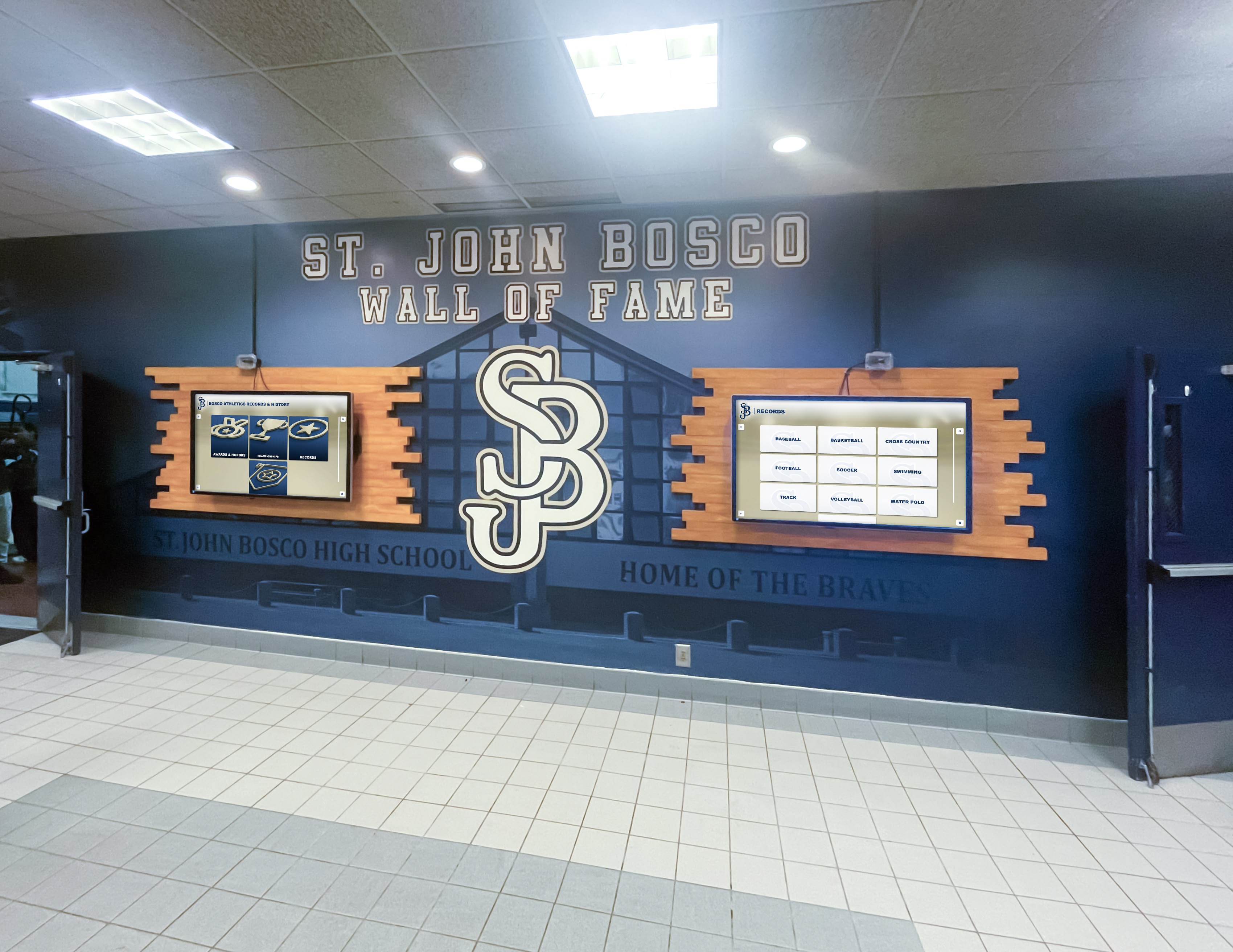
Professional installations with consistent branding communicate institutional commitment to excellence in recognition
Promotion and Visibility Strategies
Multi-Channel Promotion: Recognition programs only deliver value when communities know they exist and actively engage. Promote through diverse channels including email newsletters, social media posts, website homepage features, campus digital signage, event integration, press releases, and direct mail. Sustained, varied promotion prevents awareness gaps that undermine participation.
Alumni Ambassador Networks: Engage recognized alumni as program ambassadors who promote recognition within their networks, encourage nominations, and advocate for participation. Ambassador testimonials about meaningful recognition experiences provide credible endorsements that institutional marketing cannot replicate.
Student Engagement Initiatives: Introduce recognition programs prominently during orientation, feature them in career counseling, incorporate them into academic programs, and highlight them during campus tours. Early, repeated exposure ensures students understand recognition as integral to institutional culture rather than peripheral program.
Media Relations: Newsworthy recognition—especially of prominent alumni—merits press releases and media outreach to local, regional, or national outlets. Media coverage amplifies visibility while conferring third-party validation that enhances perceived prestige.
Event Integration: Feature recognition displays prominently at alumni events, reunions, athletic contests, fundraising galas, and institutional ceremonies. Physical presence creates interaction opportunities while reinforcing that recognition pervades institutional culture rather than existing only in dedicated spaces.
Common Challenges and Strategic Solutions
Even well-planned recognition programs encounter predictable obstacles. Proactive strategies address these challenges before they undermine program success.
Limited Budget Resources
Phased Implementation Approach: Begin with core capabilities serving highest-priority populations, then expand incrementally as budgets permit and value demonstrates. Initial phases might focus on distinguished alumni awards and basic digital displays, growing to comprehensive recognition across all categories and eras over subsequent years.
Alternative Funding Sources: Recognition programs attract donor support when framed as visible, lasting institutional investments. Solicit gifts specifically funding recognition systems, particularly from alumni classes, professional affinity groups, or individuals seeking named giving opportunities. “Presented by” sponsorships offset costs while honoring underwriters.
Volunteer Engagement: Leverage volunteer support for tasks not requiring staff expertise—historical research, photo collection, biographical interviews, event assistance. Student workers, class reunion volunteers, and retired faculty often willingly assist with recognition projects, extending capacity without proportional budget increases.
Content Development Capacity
Alumni Self-Service Tools: Enable recognized alumni to submit biographical updates, photos, video testimonials, and career milestones through self-service portals. Staff review and approve submissions before publication, but volunteer contributions dramatically accelerate content development while ensuring currency as circumstances change.
Tiered Content Strategies: Create comprehensive showcase profiles for featured honorees receiving special emphasis while developing streamlined profiles for broader recognition populations. Tiered approaches balance quality aspirations with scalability realities, allowing extensive recognition without overwhelming resources.
Outsourced Services: Consider professional content development services for video production, biographical writing, photo editing, or historical research when internal capacity limits quality or volume. Strategic outsourcing delivers professional results without permanent staff expansion.
Technology Adoption Hesitancy
Comprehensive Training: Thorough training ensures staff feel confident managing recognition technology despite limited technical backgrounds. Hands-on practice, reference materials, ongoing support access, and refresher sessions prevent frustration while enabling independent operation.
Simplified Platforms: Select recognition technologies specifically designed for non-technical users rather than repurposing generic tools requiring customization expertise. Purpose-built platforms like Rocket Alumni Solutions provide intuitive interfaces that advancement professionals operate confidently without IT assistance.
Responsive Vendor Support: Prioritize providers offering accessible, responsive technical support via multiple channels—phone, email, chat, video. When questions or issues arise, prompt assistance prevents minor problems from escalating into major frustrations that undermine staff confidence and program sustainability.
Maintaining Long-Term Momentum
Scheduled Milestones: Establish recurring recognition milestones—annual induction ceremonies, quarterly profile additions, monthly alumni spotlights—that create predictable rhythms preventing programs from fading into inconsistent, reactive acknowledgment. Calendar commitments build momentum while generating regular content for communications.
Stakeholder Accountability: Assign specific responsibilities to multiple stakeholders rather than concentrating ownership with single individuals. Distributed accountability through formal committees, role-based assignments, and leadership oversight ensures recognition remains prioritized despite competing demands or personnel changes.
Impact Communication: Regularly communicate recognition program impact through metrics, testimonials, success stories, and examples. Demonstrating value maintains institutional support and resource commitments while preventing recognition from being perceived as optional courtesy rather than strategic investment.

Integrated recognition displays become permanent fixtures that communicate institutional values to daily campus visitors
Case Examples: Recognition Programs Driving Results
Examining how diverse institutions implement recognition provides practical insights while illustrating principles in action.
Small Liberal Arts College: Comprehensive Digital Recognition
A 1,200-student liberal arts college with 8,000 living alumni faced recognition challenges common to small institutions—limited budgets, small staff, and physical space constraints that accommodated only recent awards while historical achievers languished in storage. Their solution combined strategic planning with modern technology to create comprehensive recognition serving advancement objectives.
Implementation Approach: The college launched a digital recognition platform combining a 55-inch touchscreen display in their main building lobby with a responsive website accessible globally. Initial content focused on 50 distinguished alumni across athletics, academics, service, and professional achievement, with plans to add 25-50 profiles annually.
Content Strategy: Rather than attempting immediate comprehensive coverage, they prioritized recent award winners, living alumni willing to provide content, and historical figures with readily available documentation. Student workers from communications programs conducted interviews, gathered photos, and drafted profiles under professional staff supervision, extending capacity while providing experiential learning.
Results Achieved: Within 18 months, the platform hosted 120 comprehensive profiles with photos, biographical narratives, and video testimonials. Physical display interactions averaged 200+ monthly sessions lasting 4.5 minutes. Website traffic reached 350 unique monthly visitors with 65% accessing via mobile devices. Critically, recognized alumni showed 28% higher giving rates and 40% higher event attendance compared to unrecognized peers. Major gift conversations increasingly referenced recognition as stewardship opportunity, contributing to three $100,000+ commitments within two years.
Regional University: Athletics Hall of Fame Expansion
A 15,000-student regional university with strong athletic traditions maintained a traditional athletics hall of fame featuring plaques in their stadium concourse. Limitations became increasingly problematic—adding inductees required expensive plaque manufacturing, wall space was nearly exhausted, information was minimal, and visibility was limited to those attending athletic events.
Implementation Approach: The university transitioned to an interactive touchscreen system in their athletic facility entrance while maintaining existing plaques as historical artifacts. The digital platform accommodated all previous inductees plus expanded categories including all-conference athletes, record holders, and championship teams previously unrecognized due to space constraints.
Content Strategy: They digitized all existing plaque information as baseline content, then systematically enhanced profiles by contacting living inductees for photos, career updates, and video messages. Historical inductees received profiles based on archival research—yearbooks, newspaper articles, and program records. Student-athletes participated in unveiling ceremonies, creating cross-generational connections.
Results Achieved: The system launched with 180 profiles covering 50 years of athletic excellence. Unlimited capacity enabled recognition of all letter-winners through searchable database, not just hall of fame inductees. Social sharing generated significant visibility—inductee announcement posts reached 10,000+ impressions. Reunions increasingly featured display tours and recognition ceremonies. Most significantly, athletic fundraising increased 35% following implementation, with multiple donors crediting recognition inspiration for major gifts supporting athletic scholarships.
Large State University: Integrated Recognition Ecosystem
A 30,000-student flagship university with 250,000+ alumni sought recognition infrastructure supporting diverse achievement across academic, athletic, professional, and service categories while integrating with broader advancement strategy.
Implementation Approach: They deployed multiple touchscreen displays across campus—alumni center, main library, student union, athletic facilities—each featuring content tailored to location context while drawing from centralized database. Companion website provided global access. Recognition committee structure addressed various achievement categories through specialized subcommittees.
Content Strategy: The university established annual recognition cycles adding 50-75 alumni yearly across categories. Content development distributed across advancement team members with category expertise—athletic staff managed sport recognition, academic college liaisons identified scholarly achievement, development officers surfaced donor recognition candidates. Cloud-based content management enabled this distributed authorship while maintaining consistency through editorial oversight.
Results Achieved: Within three years, the integrated system featured 800+ comprehensive profiles with professional photography, video interviews, and detailed career narratives. Physical displays logged 5,000+ monthly interactions across locations. Website traffic exceeded 8,000 unique monthly visitors with strong engagement metrics—6+ minute average sessions and 4+ profiles viewed per visit. Advancement impact was substantial—recognition program attribution for $12M+ in major gifts, 40% higher giving rates among recognized alumni, and significant volunteer recruitment through honoree engagement. Recognition became central to institutional identity and advancement strategy.
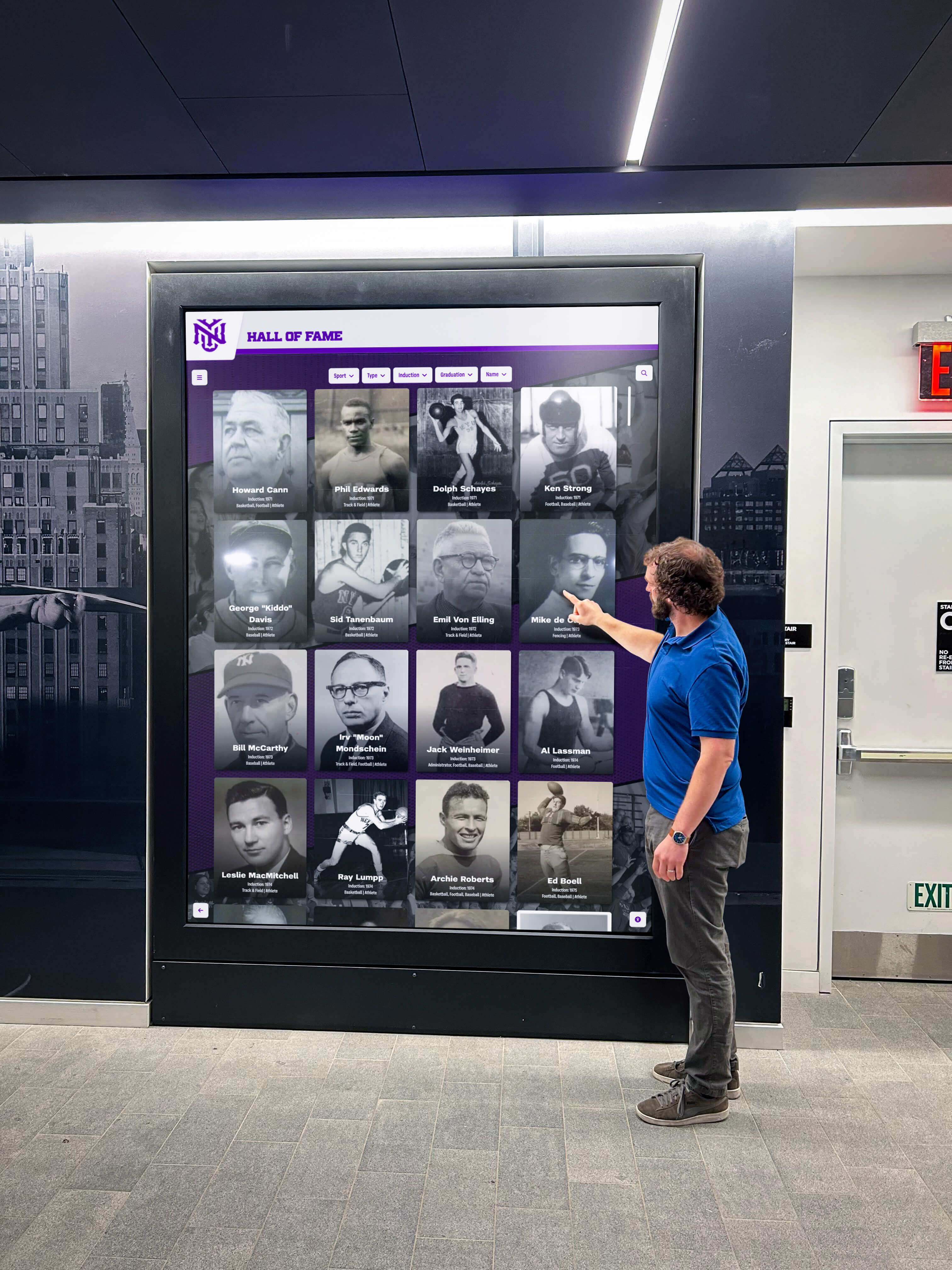
Engaging recognition experiences create memorable interactions that strengthen institutional connections
The Future of Alumni Recognition: Emerging Trends
Recognition practices continue evolving as technologies advance and generational expectations shift. Understanding emerging trends helps institutions implement systems that remain relevant as practices mature.
Personalization and Artificial Intelligence
AI capabilities increasingly enable personalized recognition experiences tailored to individual interests, backgrounds, and engagement patterns. Machine learning algorithms analyze viewing behaviors to recommend relevant profiles—classmates, similar career paths, shared professional interests. Natural language processing enables conversational search accepting queries like “show me entrepreneurs from the 1990s” rather than requiring precise name spelling or category knowledge. Automated content enhancement through AI-powered photo restoration, video transcription, biographical writing assistance, and content tagging reduces manual work while improving quality.
Gamification and Interactive Engagement
Gamification techniques apply game design elements to recognition platforms, increasing engagement through achievement unlocks, scavenger hunt challenges, trivia competitions, and social leaderboards. Alumni might earn digital badges for exploring different achievement categories, discovering hidden historical facts, or connecting with recognized graduates. Interactive features transform passive viewing into active participation that drives deeper engagement and longer interaction times.
Blockchain Credentials and Verifiable Recognition
Distributed ledger technology enables tamper-proof digital credentials documenting recognition permanently in blockchain records. These verifiable credentials provide portable achievement verification that alumni control and share across professional networks, social media, or with employers. Blockchain recognition creates permanent, ownable records that transcend institutional systems while providing cryptographic verification preventing fraudulent claims.
Virtual and Augmented Reality Experiences
Immersive technologies create novel recognition experiences. Virtual reality enables remote alumni to explore digital halls of fame through headsets, experiencing recognition spaces as if physically present regardless of geographic location. Augmented reality overlays digital content onto physical environments when users point smartphones at displays or spaces, bridging traditional and digital recognition. These technologies particularly benefit institutions with geographically dispersed alumni communities for whom campus visits remain infrequent.
Social Impact Documentation and Storytelling
Future recognition increasingly emphasizes impact documentation—not just what alumni achieved, but what difference their achievements made for communities, industries, or society. Impact-focused recognition answers the “so what” question, helping visitors understand why achievements matter beyond individual success. This trend reflects broader cultural emphasis on purpose, meaning, and contribution that resonates particularly with younger generations.
Conclusion: Recognition as Strategic Institutional Investment
Alumni recognition represents far more than ceremonial courtesy—it’s strategic infrastructure that strengthens relationships, demonstrates educational impact, inspires current students, cultivates donors, and preserves institutional memory. The most successful institutions treat recognition as ongoing commitment rather than occasional project, investing resources, leadership attention, and sustained effort into programs that deliver measurable advancement results.
Modern recognition technology transforms what’s possible. Digital platforms eliminate space constraints that historically limited recognition to small elite groups, enabling comprehensive celebration of diverse achievement across all eras and disciplines. Interactive touchscreen displays create engaging experiences that passive plaques cannot match, while web-based platforms extend recognition globally to alumni who rarely visit campus. Cloud-based content management enables sustainable administration by non-technical staff, preventing programs from becoming unsustainable burdens requiring specialized expertise.
Yet technology alone doesn’t guarantee success. Effective recognition requires strategic thinking about criteria that ensure fairness and inclusivity, compelling content that tells authentic stories beyond basic credentials, sustained promotion that prevents awareness gaps, and data-driven refinement that continuously improves programs based on usage patterns and engagement metrics. Most critically, recognition demands institutional commitment—leadership support, adequate resources, clear accountability, and long-term perspective that views recognition as permanent infrastructure rather than temporary initiative.
For institutions ready to implement or revitalize recognition programs, comprehensive solutions like those from Rocket Alumni Solutions provide proven platforms combining sophisticated technology with intuitive management and dedicated support. From strategic planning through ongoing optimization, the right partner transforms recognition from administrative burden into engagement engine that celebrates achievement while advancing institutional priorities.
Alumni recognition honors the remarkable individuals who validate educational missions through their accomplishments and contributions. When recognition programs combine meaningful acknowledgment with strategic engagement capabilities, they create value extending far beyond simple displays—building pride, strengthening bonds, inspiring students, cultivating donors, and demonstrating education’s lasting impact across generations. The investment in comprehensive recognition returns dividends in community strength, institutional reputation, and advancing missions for decades to come.
Ready to Transform Your Alumni Recognition Program?
Discover how Rocket Alumni Solutions can help you create comprehensive recognition programs that celebrate achievements, strengthen connections, and drive measurable engagement through interactive digital technology designed specifically for educational institutions.
Schedule Your Free Consultation






























